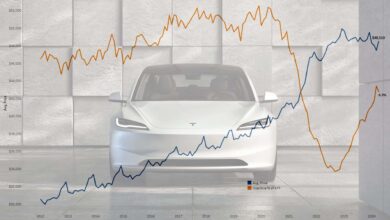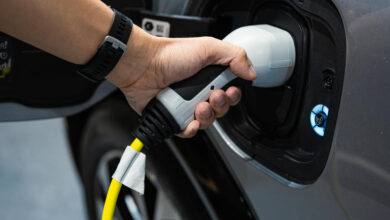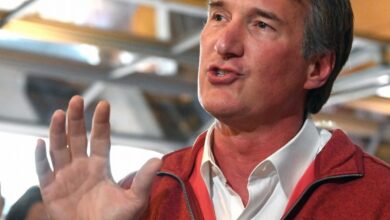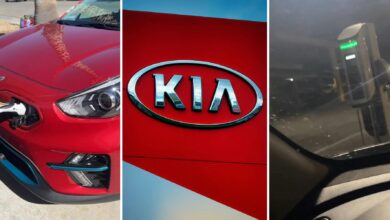Tesla, Rivian, And Nio Stock Prices Down As EV Demand Growth Slows
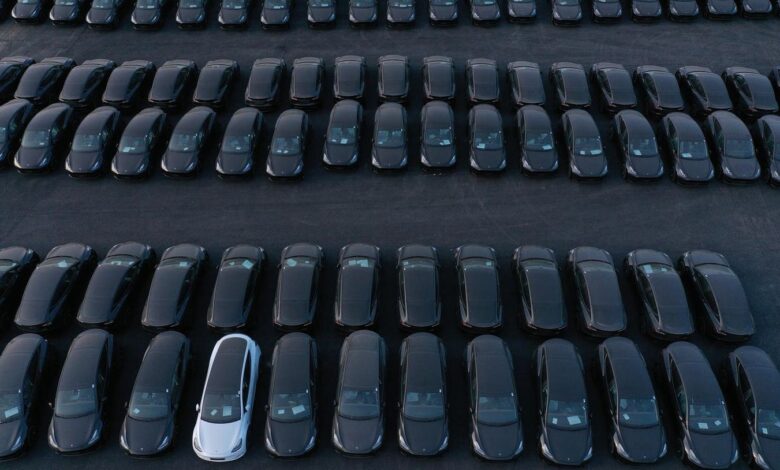
GRUENHEIDE, GERMANY – MARCH 25: In this aerial view newly completed Tesla Model Y electric cars … [+]
The stock prices of electric vehicle makers Tesla
Tesla
That decline stems from two factors:
- Early EV adopters — people who like to be the first to own a new technology product — are no longer fueling as much growth.
- Pragmatic EV buyers — those who seeking the most cost-effective solution to their driving needs — are not thrilled by high EV prices, limited driving range, and long battery charging times.
Shares of these three companies are down due to company-specific factors related to declining demand:
- Tesla stock down 30% through May 8, 2024 due to declining shipments, high vehicle prices, lack of new products, and fresh legal problems related to its self-driving software
- Rivian stock down 51% after reporting a huge negative gross margin as the company tries to scale enough to lower its per unit costs.
- Nio stock down 38% also suffers from negative gross margins while deliveries have risen in the most recent month.
“It worth having a look at the press release and shareholder letter from Q1,” a Rivian spokesperson emailed me May 9.
I requested comment from Tesla and Nio and will update this post if I receive a response.
Why EV Demand Is Slowing Down
EV demand growth is rising more slowly as early-adopters — who ignored problems with the vehicles — have done their buying. This leaves the market open to rivals who can overcome the significant challenges of satisfying the needs of more pragmatic buyers.
Most early adopters have bought their EVs. “All the early adopters, and all the people that live in big cities with easy access to charging, they’ve bought their EVs now,” Joseph Yoon, a consumer insights analyst at Edmunds, told NBC News. “And now the manufacturers have to figure out a way to get the regular people, if you will, to buy the cars.”
Those early adopters put up with significant challenges — which I called the Tesla paradox. For example, a reader, Ben Gordon, informed me people who own Tesla vehicles were so excited about them that they are willing — within limits — to live with their serious quality problems, according to my July 2020 Forbes post. How so? Tesla’s quality problems were worse than those of any other manufacturer, David Sargent, VP, Global Automotive at J.D. Power & Associates, told me.
By 2024, the reasons for more pragmatic buyers to reject an EV purchase were compelling. “Auto loan rates are high. Despite a recent wave of discounting, many EVs remain pricier than gas-burning cars. And an incomplete network of sometimes glitchy chargers has stoked drivers’ ‘range anxiety’ about running out of juice,” NBC News reported.
Before switching from a gasoline-powered vehicle to an EV, most consumers want three things. These include “under 20-minute charging times, a 350-mile plus driving range and a sticker price of under $50,000,” according to a Boston Consulting Group survey featured in a Forbes post.
Tesla’s Declining Sales, High Cash Burn, Poor Prospects
Tesla did a nice job of lowering expectations last month before reporting disappointing earnings for the first quarter and issuing a pessimistic forecast for the current quarter.
Specifically, Tesla’s revenue fell 9% in the first quarter, its adjusted earnings per share declined 38%, it burned through $2.53 billion in free cash flow and it forecast notably slower growth for 2024.
To his credit, Tesla CEO Elon Musk succeeded in elevating the stock price with two announcements. The first was a plan to make less expensive EVs on its existing manufacturing lines, noted Reuters. The second was China’s tentative approval of Tesla’s full self-driving in the country — where the EV-maker’s revenue fell 4% in the quarter, noted CNBC.
Tesla reportedly plans to cut 10% of its employees, noted the Verge. Musk “privately expressed a desire to lay off at least 20 percent of the company because its quarterly vehicle deliveries fell by that much,” according to a Bloomberg reported featured by the Verge. Tesla’s layoffs included its team building out Tesla’s charging network.
Tesla also could face prosecution for securities fraud over the company’s claims about its Autopilot and FSD capabilities. “U.S. prosecutors are examining whether Tesla committed securities or wire fraud by misleading investors and consumers about its electric vehicles’ self-driving capabilities,” three anonymous sources told Reuters.
The Reuters report highlights Musk’s 2016 claims that humans are not needed to drive Tesla vehicles when Autopilot is in use. The article also reports on a case where a driver was looking at his phones — relying on Autopilot to prevent accidents — before the vehicle collided with a motorcycle.
In conference calls Musk made bold claims about Autopilot. In 2016, he described Autopilot as “probably better” than a human driver. During an October 2022 call, he said a forthcoming FSD upgrade would allow customers to travel “to your work, your friend’s house, to the grocery store without you touching the wheel,” noted Reuters.
Tesla lawyers disputed the securities fraud allegations. “Mere failure to realize a long-term, aspirational goal is not fraud,” they argued in a 2022 court filing.
All these problems make it more difficult for Tesla to build vehicles that satisfy the criteria highlighted in the BCG report — faster charging times, larger driving range, and lower price.
Rivian’s Money-Losing Business Model
Rivian is losing money on every vehicle — $38,784 per vehicle — and reportedly is in talks with Apple
Apple
Here are the key numbers:
- Q1 2024 revenue: $1.204 billion, up 80% and $34 million above the analyst consensus, noted IBD.
- Q1 2024 loss per share: $1.24 — nine cents per share worse than the $1.15 analyst estimate, according to IBD.
- Q1 2024 deliveries: 13,552 — 3% below the Q4 2023 deliveries of 13,972 better than Rivian’s prediction of a 10% to 15% decline, according to IBD
- 2024 production forecast: 57,000 vehicles. “Rivian predicted that 2024 production would remain flat compared with 2023 while consumer and commercial vehicle deliveries will grow by low single digits in 2024,” wrote IBD.
Rivian is excited about its performance and prospects. “First-quarter results exceeded our outlook and set a strong foundation for the remainder of the year as we focus on continued demand generation, delivering cost and plant efficiency improvements, advancing R2 development, and driving towards profitability,” CEO RJ Scaringe said May 8 in the earnings release.
Apple — which in February 2024 canceled its Project Titan about which I co-wrote in the business school case Apple’s Electric Vehicle — could be exploring a partnership with Rivian, reported Digitmes. Rivian wouldn’t “comment on market rumors or speculation,” Scaringe said on the Q1 earnings call.
“As we think about what we’ve built as a company, one of the core elements that makes this unique is just the level of vertical integration around our software and associated electronics platforms,” he added on the earnings call.
Sadly for those hoping Apple might acquire Rivian, the Digitimes report may be as limited as “Rivian putting Apple CarPlay technology in its electric trucks and vans,” noted Motley Fool.
Will Rivian be able to lower its costs below its prices as it aims to further drop its prices to satisfy consumers?
Nio’s High Cash Burn, Dropping Stock Price
Finally, Nio presents a mixed picture to investors.
The good news is the company reported 134% delivery growth in April and the company is excited about launching its new 2024 ET7 executive sedan and recently entered into a cooperation agreement with luxury EV maker Lotus Technology on EV charging and battery swapping, according to my May 2 Forbes post.
The bad news is fierce price competition coupled with a high cash burn rate. In 2023, the Nio burned through $2.3 billion worth of free cash flow — ending the year with $5.5 billion in cash and $3.3 billion in long-term debt, I wrote last month.
Moreover, since analysts estimate losses through 2025, it is difficult to see how Nio will be able to stop the cash burn rate or lower its prices while forging a path to profitability.
I think all three companies could face serious challenges accelerating their growth as customers demand shorter charging times, larger driving range, and lower prices before they will purchase an EV.
